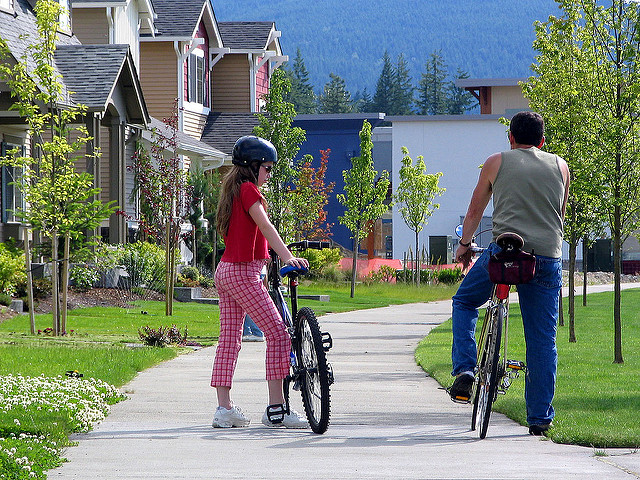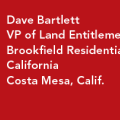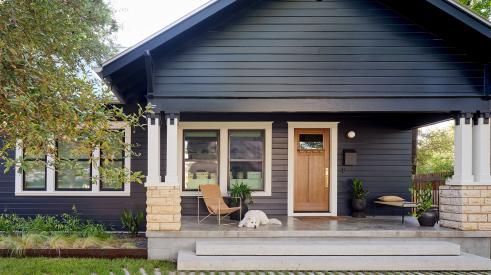
Walking encourages community, and many cities are embracing New Urbanism with policies to create sustainable, walkable, mixed-use neighborhoods where residents can walk to work, school, and other destinations to meet their daily needs. But what about the suburbs, which have long been thought of as the sprawling land of single-family detached tract housing? Dave Bartlett, who will be on the “Urban Ideas for Suburban Land” panel discussion at PCBC in San Francisco later this month, talks about bringing more urbanism to the suburbs through mixed use, public spaces, and density.
Q: Walkable communities usually are thought of as being urban. How do you define walkability?
A: It’s also about creating healthy places. We want to give the community and the residents options, so it’s about having the ability to walk out your front door, traverse the community, and have some destination points along the way such as a community center, a linear park, or a picnic area, a tot lot, and things like that. In some of these suburban master plans, you have a mixture of types of uses. We have retail uses, and it really makes sense to create public pedestrian connections to those areas. Where we don’t have retail uses, we try to see what is in the community around us and how we can get people there. So if there is a school across the street, we want to get people safely to that crosswalk in a manner that’s pedestrian friendly. Connections within the community, and connections on the outside edge are things we pay very close attention to in suburban areas to make them walkable.
Q: How do you juggle getting enough homes sold with attractive destinations—particularly retailers—that residents will want to walk to?
A: In the case of retail or schools, they typically come after the homes. But in the case of your community center and your internal pedestrian network and trail system, those are going in on day one. The first resident who moves in there is going to be able to use the pool, the rec center, the health club, whatever amenity we have in there, as well as the trails that get you around the community and to that amenity. That is a day-one exercise. I think creating density for suburban communities is critical. You’re introducing density and in return you’re going to get a little more open space and great connections to and adjacent to the community. In many cases, because of the greater density, you’ll get a lower price point. Those things become trade-offs, and hopefully drive the people who have been sitting on the fence to get into the household formation business.
Q: Density is a bad word, particularly to neighbors who oppose a new development. How do you win over the NIMBYs and city and county authorities?
A: In terms of water and sewer use on a per-household basis and also your energy use, when you have density, those factors are going to be dramatically reduced. It’s less of a tax on public services, and you’re going to have a higher efficiency home from an electricity use standpoint. Second, it’s my view that economic and social integration of a community are important, so that if I go to the grocery store, I’m not seeing a bunch of people who are just like me. It’s important for our personal growth and the growth of our society as a whole that the community is intertwined, mingling people who are making $50,000 a year with people who are making $200,000 a year. If kids and communities work together with that integration, I think it makes for healthy communities. Having a homogeneous community isn’t really giving anything to advance this notion of getting better and learning from one another. This is where our world is moving to, so when we get an opportunity to introduce density, we get a United Nations spectrum of people, and along with that we get an economic spectrum of people. I think it makes for better communities when you have different demographics available to live in your community.
Q: So we’re also talking about diversity of housing products in a community like a triplex near single-family homes. Are planned committees becoming more receptive to diverse housing types within the same community?
A: There’s always an education. In some of the Inland (Empire) areas, we actually had the opposite experience, so they would like us to do more density, but the issue there is we can’t force it. You can introduce density but if you try forcing it, you’re going to lose. By that I mean we would build something that would not sell and then you’ve got a stalled project. We have seen cases where cities want us to do more density and we have to fight back for more modest density. On the other side, we see cases where some cities are afraid of density, especially that apartment word. We have to demonstrate that it’s not the same apartment that was built on your block in 1963. This is the kind of apartment that attracts people to live in your community and stay there. Households that are living in their parents basement or the back bedroom now have a opportunity to live in a nice community. Or they can buy that first-time home, because of the density we offer. Having first-time buyer opportunities available in all communities could raise up that Millennial push and allow us to continue to prosper.
Q: Who is interested in walkable communities?
A: The buyer is the whole spectrum. We’ve done a lot of research and the number one thing that people look for in a community is connection with their neighbors. What we try to do is save that very early on in our master planned communities. We’ll do dinners, host wine tastings, movie nights, and concerts in the park to facilitate the neighbors coming together so they can form those strong bonds. They feel safer in the community. They know their kids’ friends and everyone is looking out for each other and it in essence becomes a neighborhood watch. We find it’s not a single demographic, it’s everyone from the first-time buyer of an apartment through the 55 plus. What we’re doing in an apartment community now, it’s a mostly market rate apartment with three-story walkup, and we have a section that is separate for 55 plus with elevator access. This particular community is apartment, first time buyer, second and third time buyer, and seniors all in one. We will grade it in 2017. It was recently approved by the city of Whittier (Calif.). We also have 160,000 square feet of retail associated with that.
Advertisement
Related Stories
Sales + Marketing
Q+A With Jenny Laible: The Keys to a Community Lifestyle Program
The National Association of Home Builders' 2024 Lifestyle Director of the Year talks about authenticity, knowing your neighbors, and her chill approach to social media
Construction
Q+A With Jenny Kerr Schroen and Chris Eccleston: Grit Leads to Greatness
The co-authors of Grit Leads to Greatness are finding their book's message resonates deeply with students, school administrators, and parents alike
Q+A
A Builder Discusses Product Strategy
Which products make a difference? Andrew Houlihan of Houlihan Building Company dives into what kinds of products matter to builders and their clients, including the Marvin Elevate® and Essential™ Collections








